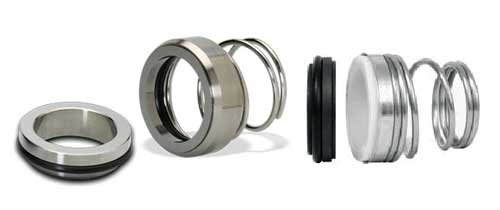What Is A Mechanical Seal?
What Is A Mechanical Seal?
What Is A Mechanical Seal?
19 Feb 2015

What Is A Mechanical Seal?
Mechanical seals are used mainly in pumping applications (although the principles are the same for mixers, blowers and compressors). In essence, the pump has two main elements; the first being a rotating shaft and the second being the pump casing. Without a seal, the pumped medium (water, waste, oil, etc) would leak and the pump would be ineffective. The mechanical pump therefore creates the seal between the moving part (dynamic) and the stationary part (static). Because of this Mechanical seals are often called many things including shaft seals, pump seals, rotary shaft seals, water pump seal and combinations of these. Whatever you call it, the product is essentially the same.
Mechanical seals or more technically “end face mechanical seals” were designed in the early 1900s but really came to prominence during the post-war boom (late 1940s) in both industrial and domestic equipment sales.
The elements of a mechanical seal are what make it unique. They are:
- Stationary component (commonly referred to as the seat).
- Stationary component sealing member.
- Rotating component.
- Rotating component sealing member.
- Spring.
- Gland plate.
- Clamp ring
The seal between the stationary component and the rotating component is called the ‘Primary Seal’ and is the most important. However there is a ‘Secondary Seal’, which is typically an O Ring and sits between the rotating component sealing member and the shaft of the pump.
The spring is used to create just the right pressure in the primary seal between the stationary and rotating surfaces.
The primary seal surface in various mechanical seal types come in a vast array of materials, such as Carbon-graphite, Silicon carbide, Tungsten carbide and Alumina ceramic. The choice of material is dependent on the medium (the liquid to be sealed), the pressures the seal must withstand and the temperatures of the medium. Speak with your mechanical seals supplier to determine the best materials for your application.
What Is So Great About Mechanical Shaft Seals?
Before the invention of mechanical seals, mechanical packings or gland packings were used. These worked well in principle, but had a higher leakage rate (not ideal for some applications) and can handle higher temperatures and pressures (thanks to the sprint component).
Additionally, the use of packing in earlier designs caused shaft and sleeve wear that reduced the life of the pump and increased costs. Mechanical seals therefore improve equipment lifespan.
The other benefit is that they are self-lubricating in that their design specifically allows a very small amount of leakage onto the sealing surface, which lubricates and keeps the primary seal from eroding. Finally, mechanical seals require virtually zero maintenance as they do not require periodic tightening as Gland packing would.
Ultimately therefore, mechanical seals are a simple, elegant and cost effective solution to creating a long-life seal in dynamic applications.
Typical Mechanical Seal Applications
Mechanical Shaft Seals are used in a wide variety of applications ranging from:
- Drainage wells pumps
- Wastewater treatment
- Centrifugal pumps
- Self-priming pumps
- Abrasive liquids pumping
- Thick liquids pumping
- High temperature liquids pumping
- High pressure liquids pumping
What Are The Key Considerations When Buying Mechanical Seals?
There are a number of very important things to consider when buying rotary shaft seals that will determine the exact configuration and material choices. Here are the most important ones:
- Dimensions: You will need to know the stationery component dimensions, the shaft dimensions, the bore dimensions and finally the working length (typically 50% of the uncompressed spring length).
- Media To Be Pumped/Sealed : It is important to determine the exact media that is to be sealed. Water, chemicals, oil, semi-solids, etc. all have different considerations and will impact on the material choice.
- Temperature: Extreme temperatures, whether high or low, will have a direct bearing on the seal material and type.
- Pressure: The amount of pressure required against the rotating component to maintain the seal will be important in determining the mix of components and materials.
- Shaft Speed: The operating speed of the equipment will have a similar impact on the seal as does temperature or pressure. In some cases the smoothness of the surface finish of equipment to be sealed in a high speed application will be very important to avoid excessive wear on the seal or, where the surface is too smooth, causing under-performance of the seal.
- Compatibility: Often overlooked, some materials/compounds are not compatible with each other and so those combinations must be avoided. Additionally, where equipment is flushed, the liquids or gases used in this process must also be determined to ensure premature degradation of the seal does not occur.
Abbey Seals International Limited is Ireland’s premier manufacturer of Gaskets and distributor of O Rings and Mechanical Seals. Established in 1983, Abbey Seals has over 30 years of expertise in gasket and seal applications across virtually every sector and industry, both domestic and international.
Abbey Seals carries 40,000+ variations of O Rings and seals in stock and can assist in the provision of custom O Rings for unique applications.
Our unique approach means that we can have the product you require delivered to your door within hours of ordering; from a single unit to thousands.
Contact Us to find out more about our products or services or to place an order.
-
Post tags
-
Mechanical Seal
